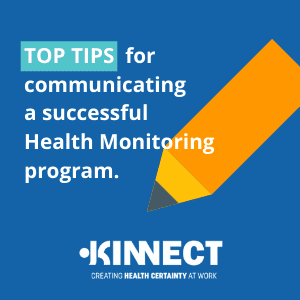Communicating with your employees about your plans to enrol them in a Health Monitoring, Periodic Health Assessment or Health Surveillance program is a really important part of achieving a successful rollout. It’s wise to get ahead of any potential concerns and address them early on.
Here are our top tips:
1.Think about your key messages
Deciding what your key messages need to be for your business is likely to be unique to your business. We generally advise our clients that the key messages to employees should focus on the importance of their health and wellbeing, and your responsibility to provide a safe work environment.
For instance:
Your health and wellbeing is really important to us. We want to make sure we are keeping you safe while you are at work AND ensure that your working environment isn’t going to cause you ill-health, now or in the future.
This is why we are launching our Periodic Health Assessment program.
2. Think about the language you use
The words and the tone you use matter. For example, that’s why some of our clients will choose to call their program a ‘Periodic Health Assessment’ program, as opposed to a ‘Health Monitoring or Health Surveillance’ program. The latter could imply that general ‘worker surveillance’ which sounds a bit scary. Although it’s the same thing, the former is softer language and may work better for your employees.
What’s important is you strike a tone that is going to get the right response from your people. You want them to engage and not run from this!
3. Get ahead of any questions and reassure your employees about their concerns
Some of your employees might be concerned about the motivations behind your program and the impact the program may have on their continued employment with your company. You need to reassure your employees that you are not performing these assessments to check whether they are fit for work or that they continue employment. Make sure your communication with employees reassures them that the program has been developed to better manage their ongoing health and wellbeing, not an attempt to remove people from the business.
Other employees may be concerned about the sharing of their private health information and what their information is used for. Be upfront about what information will be kept and for how long and who will have access to it.
There may be other concerns that are relevant to your business. Think carefully about what these are and think about how you can address these appropriately in your communications efforts.
4. Focus on the Benefits
People always want to know what’s in it for them, so your communications will benefit from focussing on the benefits. Benefits you might focus on include:
- That regular testing will help monitor their health and keep them safer at work,
- Being more informed about their own health and the potential hazards,
- The opportunity to receive an earlier warning about small health changes that could lead to better overall health and wellbeing.
- Reassurance that your work environment is not causing any health concerns,
- That they’ll receive timely treatment should a problem be identified.
- Free appointments and medical expenses with all costs and time involved covered directly by your company.
5. Be clear about how the assessments will work
Being clear on the process for assessments means everyone knows what to expect. Provide your employees with a clear plan for what happens when they are due for an assessment, what it will entail, and they will be more likely to engage positively.
Similarly, make sure that your employees understand what happens when the results of an assessment do or don’t identify a concern. If they do identify a concern, explain how your business will assist them to manage their condition, provide further evaluation of the concern with relevant medical experts. Explain that the focus will be to ensure they can continue their duties safely and productively, without continued exposure to an environment that is hazardous to their health.
Similarly, if the assessment does not identify any concerns, ensure they are informed of the next steps and when they can expect to have their next monitoring check-up.
Remember that KINNECT can help with tools and templates to help engage your people in your program and support you with a successful rollout.
Find out more about our Health Surveillance services.
Ready to partner with KINNECT?
Request a Service
Know what you need from us? Request a service from us right now.
Locate us
Have a need in a particular location? View our service capabilities throughout Australia.
